Computational Science Report: Concepts, Applications, and Analysis
VerifiedAdded on 2020/04/21
|6
|735
|145
Report
AI Summary
This report provides an overview of computational science, defining it as the intersection of algorithms, mathematics, numerical analysis, networking, and computing hardware. It highlights the interdisciplinary nature of the field, emphasizing its use of computers for solving scientific and engineering problems, performing simulations, and managing large databases. The report discusses how computational science leverages knowledge from computer science, engineering, and mathematics to gain a deeper understanding of complex problems. It explains the significance of computational simulation in providing insights into phenomena that cannot be solved by analytical methods. The report concludes by summarizing the key concepts and emphasizing the critical role of computational science in future scientific discoveries and engineering design.
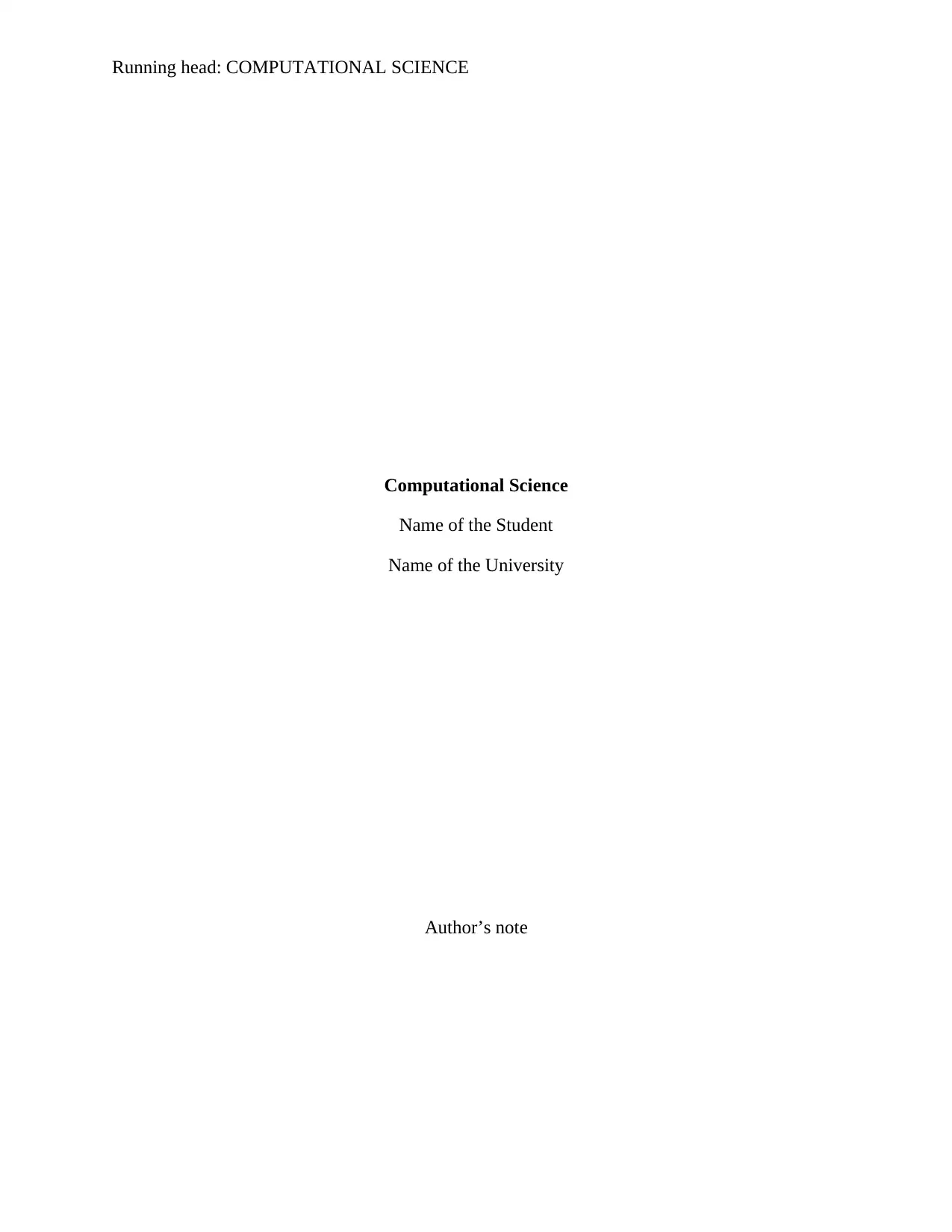
Running head: COMPUTATIONAL SCIENCE
Computational Science
Name of the Student
Name of the University
Author’s note
Computational Science
Name of the Student
Name of the University
Author’s note
Paraphrase This Document
Need a fresh take? Get an instant paraphrase of this document with our AI Paraphraser
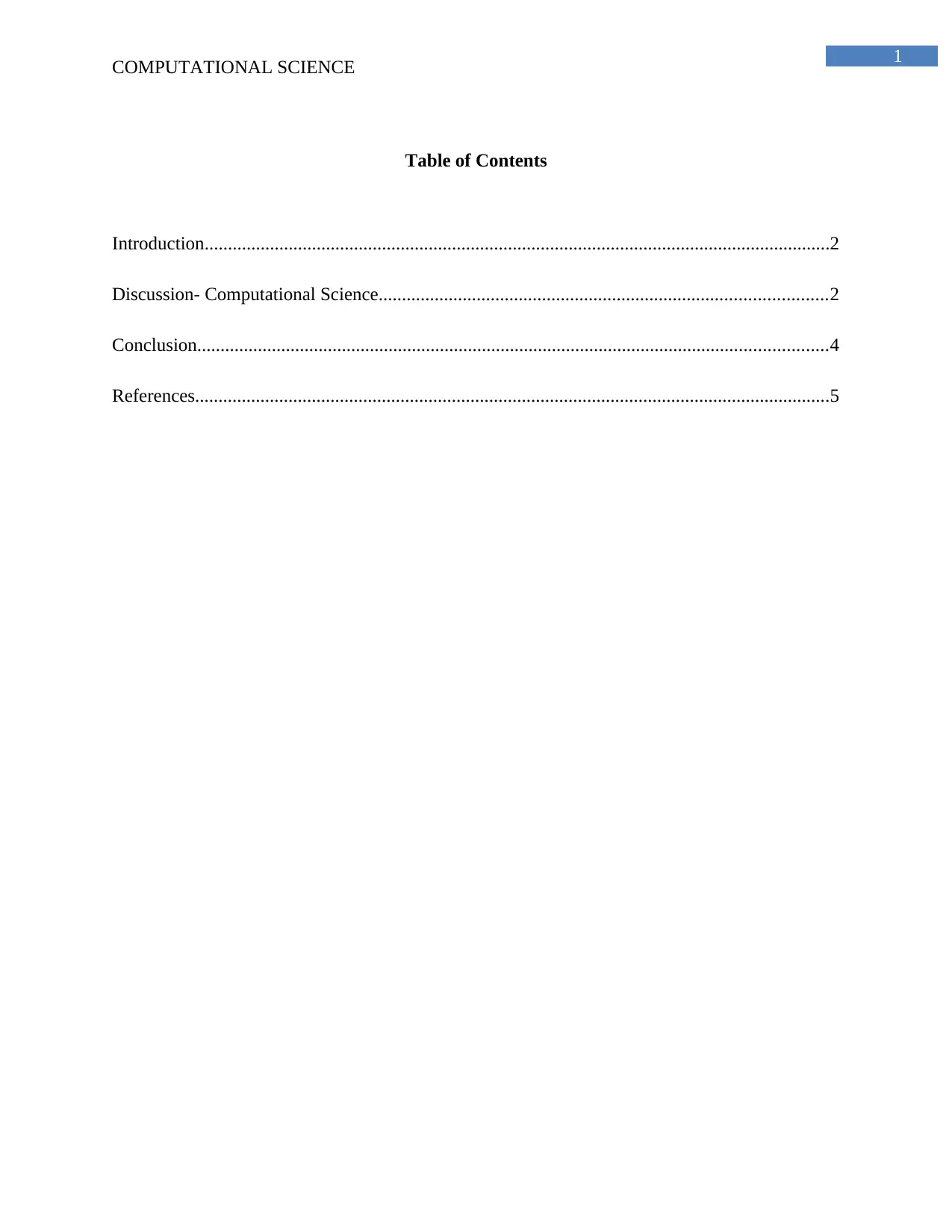
1
COMPUTATIONAL SCIENCE
Table of Contents
Introduction......................................................................................................................................2
Discussion- Computational Science................................................................................................2
Conclusion.......................................................................................................................................4
References........................................................................................................................................5
COMPUTATIONAL SCIENCE
Table of Contents
Introduction......................................................................................................................................2
Discussion- Computational Science................................................................................................2
Conclusion.......................................................................................................................................4
References........................................................................................................................................5
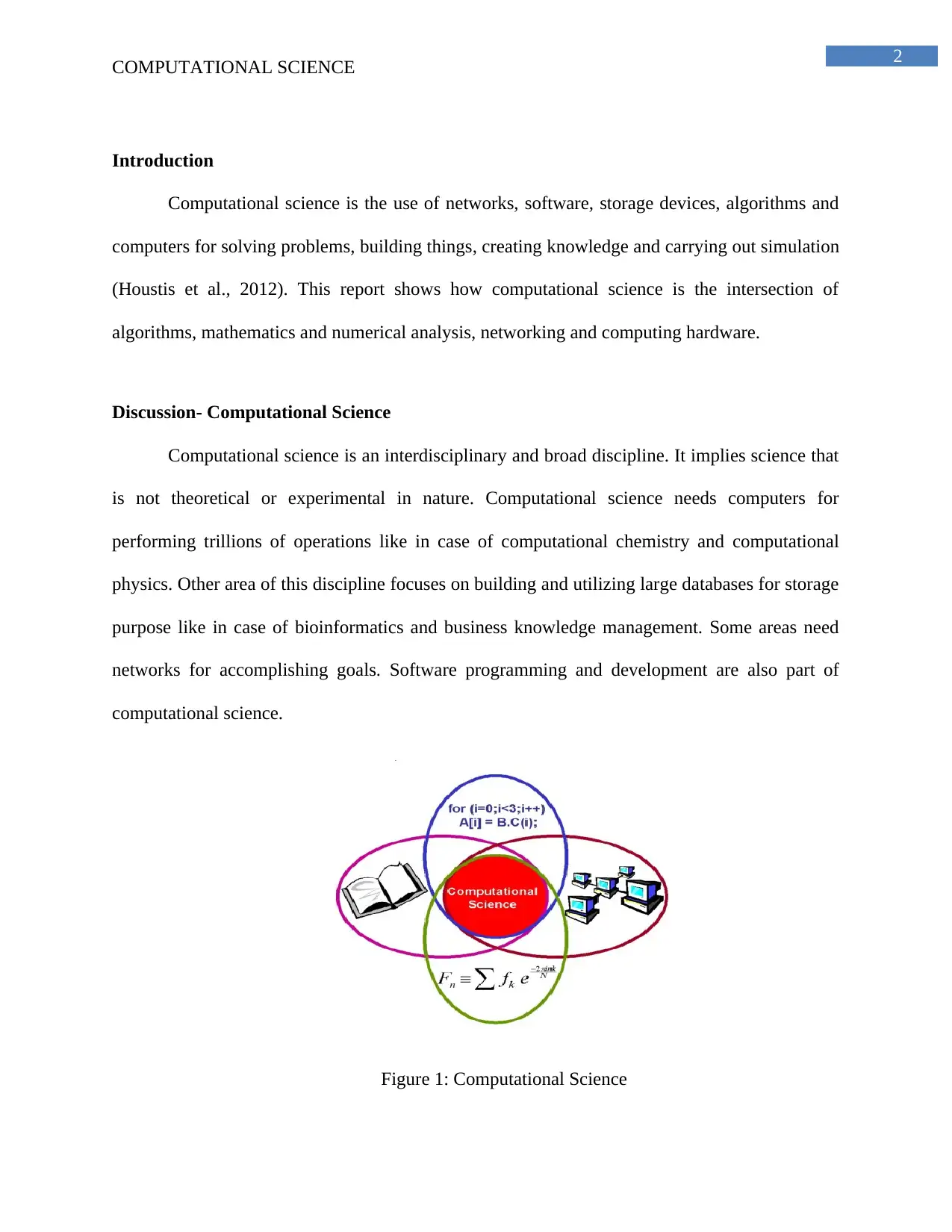
2
COMPUTATIONAL SCIENCE
Introduction
Computational science is the use of networks, software, storage devices, algorithms and
computers for solving problems, building things, creating knowledge and carrying out simulation
(Houstis et al., 2012). This report shows how computational science is the intersection of
algorithms, mathematics and numerical analysis, networking and computing hardware.
Discussion- Computational Science
Computational science is an interdisciplinary and broad discipline. It implies science that
is not theoretical or experimental in nature. Computational science needs computers for
performing trillions of operations like in case of computational chemistry and computational
physics. Other area of this discipline focuses on building and utilizing large databases for storage
purpose like in case of bioinformatics and business knowledge management. Some areas need
networks for accomplishing goals. Software programming and development are also part of
computational science.
Figure 1: Computational Science
COMPUTATIONAL SCIENCE
Introduction
Computational science is the use of networks, software, storage devices, algorithms and
computers for solving problems, building things, creating knowledge and carrying out simulation
(Houstis et al., 2012). This report shows how computational science is the intersection of
algorithms, mathematics and numerical analysis, networking and computing hardware.
Discussion- Computational Science
Computational science is an interdisciplinary and broad discipline. It implies science that
is not theoretical or experimental in nature. Computational science needs computers for
performing trillions of operations like in case of computational chemistry and computational
physics. Other area of this discipline focuses on building and utilizing large databases for storage
purpose like in case of bioinformatics and business knowledge management. Some areas need
networks for accomplishing goals. Software programming and development are also part of
computational science.
Figure 1: Computational Science
⊘ This is a preview!⊘
Do you want full access?
Subscribe today to unlock all pages.

Trusted by 1+ million students worldwide
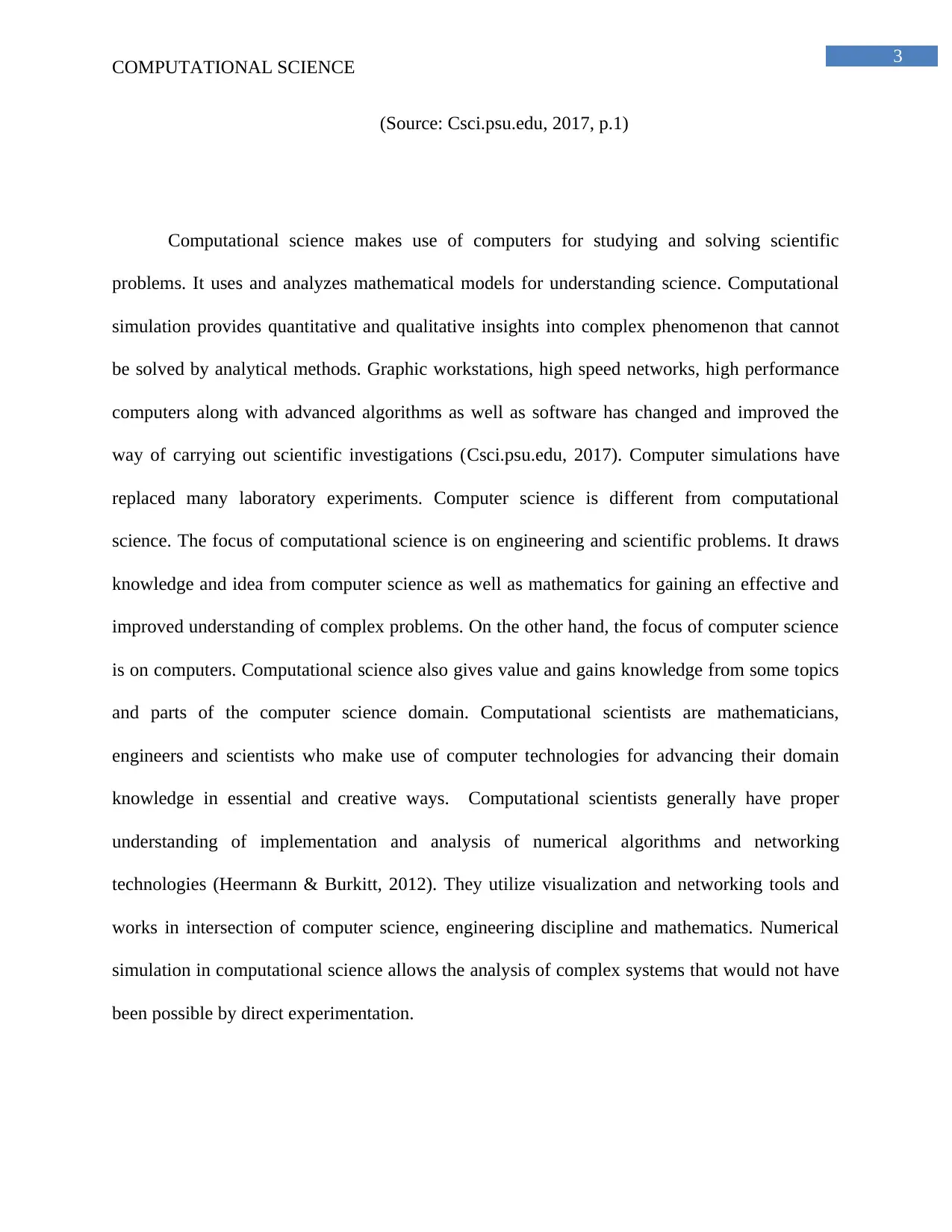
3
COMPUTATIONAL SCIENCE
(Source: Csci.psu.edu, 2017, p.1)
Computational science makes use of computers for studying and solving scientific
problems. It uses and analyzes mathematical models for understanding science. Computational
simulation provides quantitative and qualitative insights into complex phenomenon that cannot
be solved by analytical methods. Graphic workstations, high speed networks, high performance
computers along with advanced algorithms as well as software has changed and improved the
way of carrying out scientific investigations (Csci.psu.edu, 2017). Computer simulations have
replaced many laboratory experiments. Computer science is different from computational
science. The focus of computational science is on engineering and scientific problems. It draws
knowledge and idea from computer science as well as mathematics for gaining an effective and
improved understanding of complex problems. On the other hand, the focus of computer science
is on computers. Computational science also gives value and gains knowledge from some topics
and parts of the computer science domain. Computational scientists are mathematicians,
engineers and scientists who make use of computer technologies for advancing their domain
knowledge in essential and creative ways. Computational scientists generally have proper
understanding of implementation and analysis of numerical algorithms and networking
technologies (Heermann & Burkitt, 2012). They utilize visualization and networking tools and
works in intersection of computer science, engineering discipline and mathematics. Numerical
simulation in computational science allows the analysis of complex systems that would not have
been possible by direct experimentation.
COMPUTATIONAL SCIENCE
(Source: Csci.psu.edu, 2017, p.1)
Computational science makes use of computers for studying and solving scientific
problems. It uses and analyzes mathematical models for understanding science. Computational
simulation provides quantitative and qualitative insights into complex phenomenon that cannot
be solved by analytical methods. Graphic workstations, high speed networks, high performance
computers along with advanced algorithms as well as software has changed and improved the
way of carrying out scientific investigations (Csci.psu.edu, 2017). Computer simulations have
replaced many laboratory experiments. Computer science is different from computational
science. The focus of computational science is on engineering and scientific problems. It draws
knowledge and idea from computer science as well as mathematics for gaining an effective and
improved understanding of complex problems. On the other hand, the focus of computer science
is on computers. Computational science also gives value and gains knowledge from some topics
and parts of the computer science domain. Computational scientists are mathematicians,
engineers and scientists who make use of computer technologies for advancing their domain
knowledge in essential and creative ways. Computational scientists generally have proper
understanding of implementation and analysis of numerical algorithms and networking
technologies (Heermann & Burkitt, 2012). They utilize visualization and networking tools and
works in intersection of computer science, engineering discipline and mathematics. Numerical
simulation in computational science allows the analysis of complex systems that would not have
been possible by direct experimentation.
Paraphrase This Document
Need a fresh take? Get an instant paraphrase of this document with our AI Paraphraser
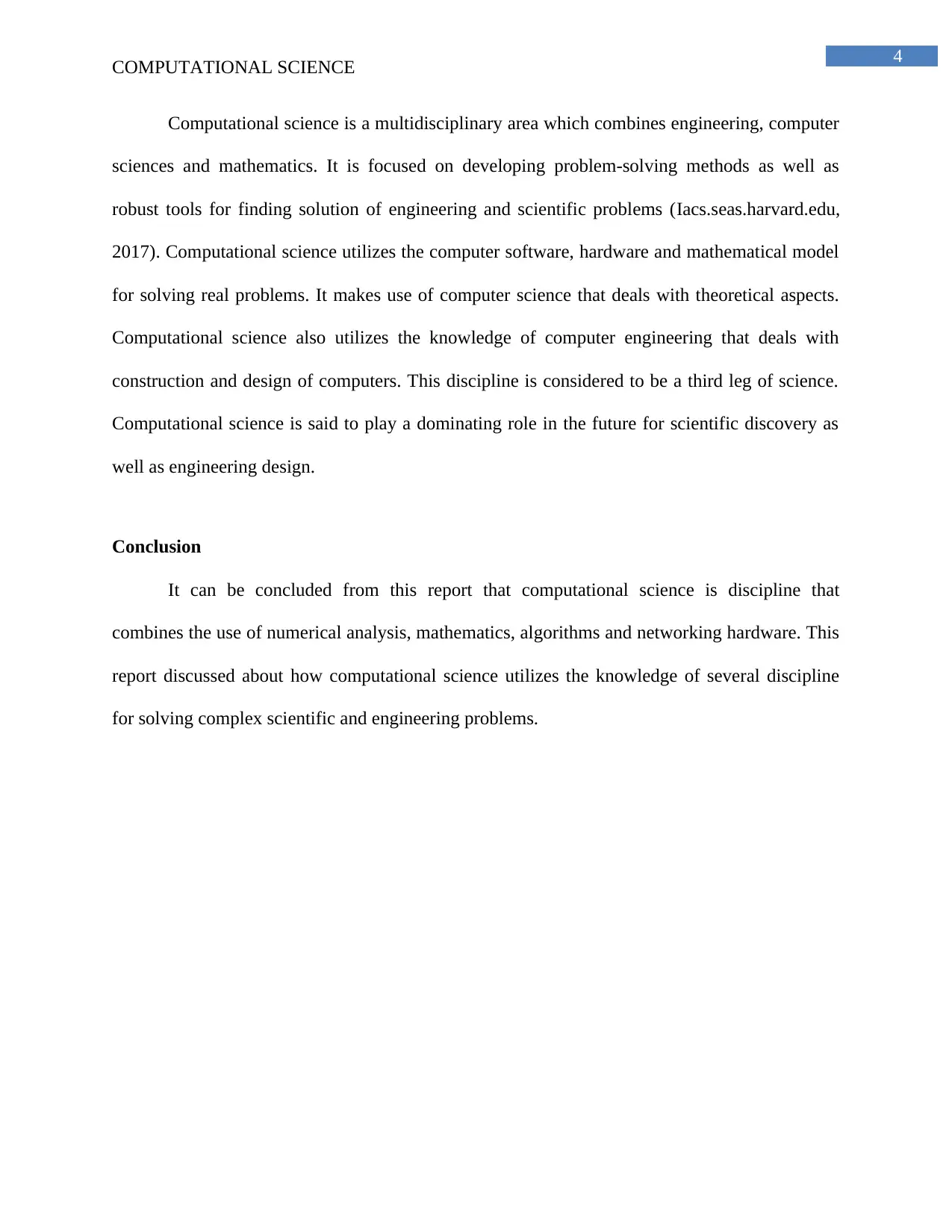
4
COMPUTATIONAL SCIENCE
Computational science is a multidisciplinary area which combines engineering, computer
sciences and mathematics. It is focused on developing problem-solving methods as well as
robust tools for finding solution of engineering and scientific problems (Iacs.seas.harvard.edu,
2017). Computational science utilizes the computer software, hardware and mathematical model
for solving real problems. It makes use of computer science that deals with theoretical aspects.
Computational science also utilizes the knowledge of computer engineering that deals with
construction and design of computers. This discipline is considered to be a third leg of science.
Computational science is said to play a dominating role in the future for scientific discovery as
well as engineering design.
Conclusion
It can be concluded from this report that computational science is discipline that
combines the use of numerical analysis, mathematics, algorithms and networking hardware. This
report discussed about how computational science utilizes the knowledge of several discipline
for solving complex scientific and engineering problems.
COMPUTATIONAL SCIENCE
Computational science is a multidisciplinary area which combines engineering, computer
sciences and mathematics. It is focused on developing problem-solving methods as well as
robust tools for finding solution of engineering and scientific problems (Iacs.seas.harvard.edu,
2017). Computational science utilizes the computer software, hardware and mathematical model
for solving real problems. It makes use of computer science that deals with theoretical aspects.
Computational science also utilizes the knowledge of computer engineering that deals with
construction and design of computers. This discipline is considered to be a third leg of science.
Computational science is said to play a dominating role in the future for scientific discovery as
well as engineering design.
Conclusion
It can be concluded from this report that computational science is discipline that
combines the use of numerical analysis, mathematics, algorithms and networking hardware. This
report discussed about how computational science utilizes the knowledge of several discipline
for solving complex scientific and engineering problems.
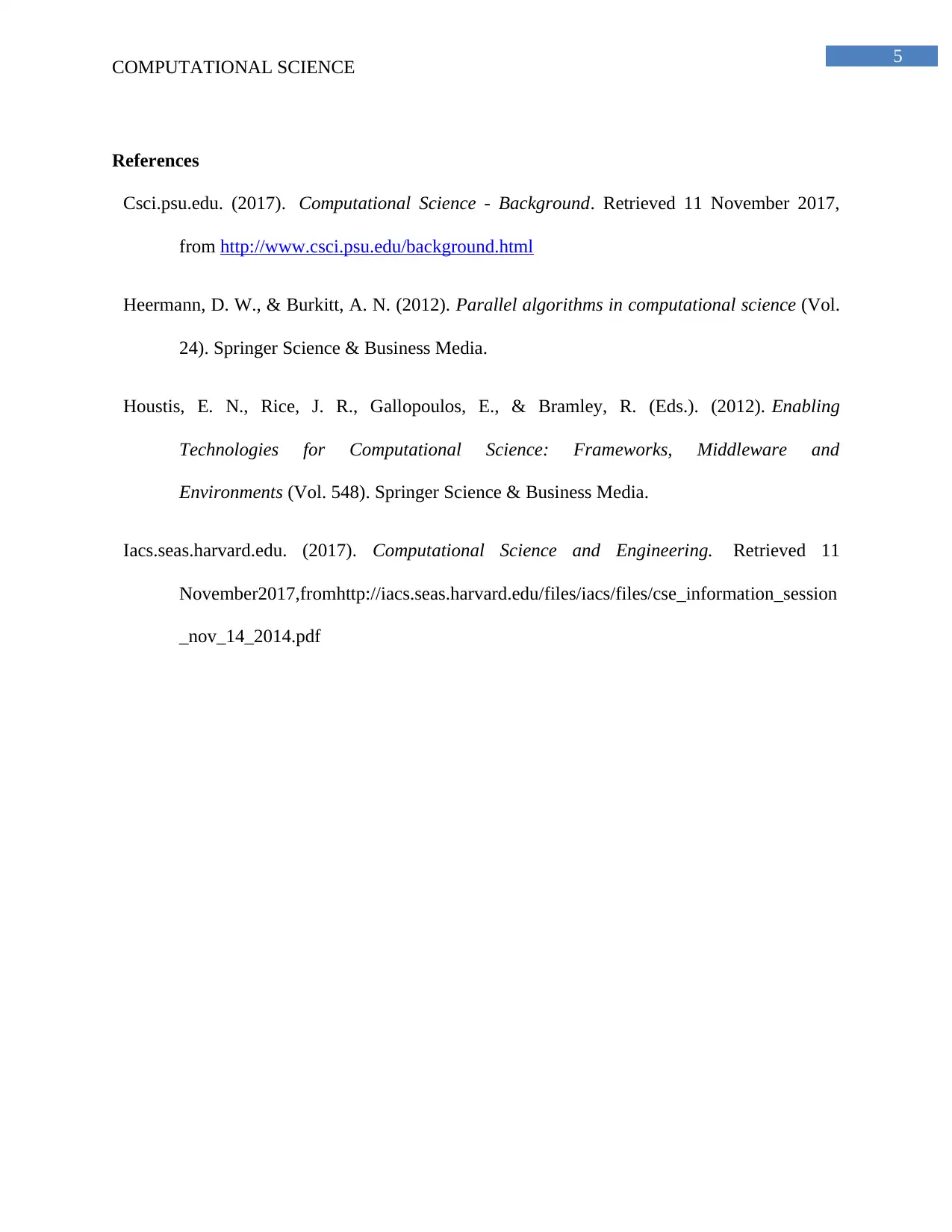
5
COMPUTATIONAL SCIENCE
References
Csci.psu.edu. (2017). Computational Science - Background. Retrieved 11 November 2017,
from http://www.csci.psu.edu/background.html
Heermann, D. W., & Burkitt, A. N. (2012). Parallel algorithms in computational science (Vol.
24). Springer Science & Business Media.
Houstis, E. N., Rice, J. R., Gallopoulos, E., & Bramley, R. (Eds.). (2012). Enabling
Technologies for Computational Science: Frameworks, Middleware and
Environments (Vol. 548). Springer Science & Business Media.
Iacs.seas.harvard.edu. (2017). Computational Science and Engineering. Retrieved 11
November2017,fromhttp://iacs.seas.harvard.edu/files/iacs/files/cse_information_session
_nov_14_2014.pdf
COMPUTATIONAL SCIENCE
References
Csci.psu.edu. (2017). Computational Science - Background. Retrieved 11 November 2017,
from http://www.csci.psu.edu/background.html
Heermann, D. W., & Burkitt, A. N. (2012). Parallel algorithms in computational science (Vol.
24). Springer Science & Business Media.
Houstis, E. N., Rice, J. R., Gallopoulos, E., & Bramley, R. (Eds.). (2012). Enabling
Technologies for Computational Science: Frameworks, Middleware and
Environments (Vol. 548). Springer Science & Business Media.
Iacs.seas.harvard.edu. (2017). Computational Science and Engineering. Retrieved 11
November2017,fromhttp://iacs.seas.harvard.edu/files/iacs/files/cse_information_session
_nov_14_2014.pdf
⊘ This is a preview!⊘
Do you want full access?
Subscribe today to unlock all pages.

Trusted by 1+ million students worldwide
1 out of 6
Related Documents
Your All-in-One AI-Powered Toolkit for Academic Success.
+13062052269
info@desklib.com
Available 24*7 on WhatsApp / Email
![[object Object]](/_next/static/media/star-bottom.7253800d.svg)
Unlock your academic potential
Copyright © 2020–2025 A2Z Services. All Rights Reserved. Developed and managed by ZUCOL.




